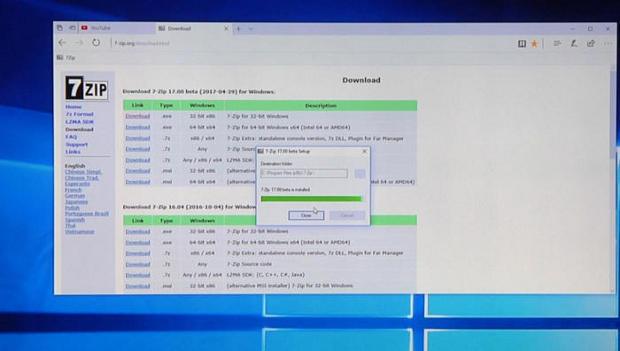Microsoft and chipmaker Qualcomm have raised the ire of Intel as they prepare to launch a full version of Windows 10 on ARM processors with x86 application emulation technology.
When they arrive later this year, Qualcomm’s Snapdragon chips will represent the first ARM-based processors that can run Windows 10 on energy-efficient mobile and desktop computers.
In December, Microsoft and Qualcomm announced they were working to build a range of Qualcomm Snapdragon-powered Windows 10 PCs that run x86 Win32 and universal Windows apps, including Adobe Photoshop, Microsoft Office and popular Windows games.
“Windows 10 powered by Snapdragon processors will offer the same apps and features as Windows 10 on tablets, notebooks, laptops, and PCs. Devices will run Universal Windows Platform (UWP) and Win32 apps through emulation,” Qualcomm said in a December blog post.
Microsoft further discussed its new category of Always Connected PCs at the Build conference last month; and Microsoft’s PC-maker partners demonstrated some of the new capabilities through the Snapdragon platform at the Computex 2017 expo last week.
Microsoft announced that ASUS, HP and Lenovo will be the first manufacturers to launch Always Connected Windows 10 devices using Qualcomm’s Snapdragon 835 Mobile PC Platform, according to a published report.
“These new devices will feature Windows, always-on LTE connectivity and great battery life,” Microsoft said at Computex.
In a blog post, Intel’s chief lawyer, Stephen Rodgers, and labs director Richard A. Uhlig fired a shot across Microsoft’s and Qualcomm’s collective bow.
“There have been reports that some companies may try to emulate Intel’s proprietary x86 ISA without Intel’s authorization,” the blog stated. “We do not welcome unlawful infringement of our patents, and we fully expect other companies to continue to respect Intel’s intellectual property rights. Intel carefully protects its x86 innovations, and we do not widely license others to use them.”
The two Intel executives pointed out that emulation is not a new technology, and the last company that claimed to have produced a compatible x86 processor using emulation – Transmeta – wound up in court.
“In any event, Transmeta was not commercially successful, and it exited the microprocessor business 10 years ago,” Intel said. “Only time will tell if new attempts to emulate Intel’s x86 ISA will meet a different fate.”
Intel’s reference to the 2007 Transmeta civil lawsuit was an odd one. Initially, it was Transmetta that sued Intel over patent infringement. Then Intel countersued. In the end, Intel wound up paying $250 million and licensed Transmeta’s technology.
“I’m not sure why you would want to bring up something where you had to pay the other party compensation,” said Mark Hung, research vice president for IoT and wireless technology at Gartner. “But, there’s no question that blog post was directed at this Microsoft-Qualcomm announcement.”
It’s been a long time since Intel had to defend its x86 platform, which was regularly emulated by companies in the 1980s and 1990s. But Intel feels threatened by this particular announcement because the 800-pound gorilla in the mobile phone space – Qualcomm – is now “starting to leverage their investment in that market to encroach on Intel’s turf in PCs and laptops,” Hung said.
When Microsoft launched its Surface tablet in 2012 – it was based on Qualcomm’s ARM processors – the device ran Windows RT with a severely limited number of applications. Conversely, the Surface Pro tablet, based on Intel’s Core i Series processors, can handle the full gamut of Windows apps.
“The Surface and Windows RT never went anywhere because it was limited in terms of the types of Windows applications it could run,” Hung said.
The recent collaboration between Microsoft and Qualcomm means enterprise users will be able to run the full range of Windows applications on ARM-based processors.
“The significance for the enterprise is that if you need to run Windows, you’re no longer exclusively tied to Intel, and to a lesser extent AMD. Now you have a third choice with Qualcomm and maybe some other ARM processor vendors in the future,” Hung said.
In a mobile-first world, the question becomes how does Microsoft want to support the PC market; for Qualcomm, it’s about how it can diversify into new markets.
Microsoft and Qualcomm want to capture some of the enterprise market where having devices that can take advantage of both LAN and WAN connectivity is critical, longer battery life is important, and a full version of Windows 10 and its applications are supported.
“Given that these days a lot of the workloads are moving to the cloud, how much compute power you really need on the client side is continuously being adjusted,” Hung said. “So, it’s not necessarily that the Qualcomm-Microsoft platform will be the best laptop and notebook platform, but given the full spectrum of needs that enterprise users have, this will address road warriors that are on the go and not necessarily always plugged in.”
IDG News Service





Subscribers 0
Fans 0
Followers 0
Followers